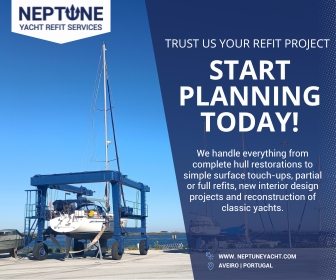ARGONAUTA I’s Passage Notes Spain to Gibraltar
This report covers items that might be useful considerations when planning a westbound cruise from southern France through the Mediterranean to Gibraltar.
Published 19 years ago, updated 7 years ago
ARGONAUTA I: Passage Notes Spain to Gibraltar July to September 2005
Crewed by Hugh, Heather and David Bacon in ARGONAUTA I
ARGONAUTA I, a highly modified Beneteau 440, has just completed an extended world cruise. We began in the Caribbean in 1997, transited the Panama Canal in 1999 and crossed the Pacific to Australia. Our passage from Australia took us from Darwin via the Indian Ocean and the Red Sea to Kemer in Turkey where we left the yacht in dry storage winter 2003/2004. We then continued on to France and after a winter in dry storage at Port Napoleon, France, we continued in July 2005 to Spain and Gibraltar. Later in 2005, we carried on to Morocco and the Atlantic Islands. In early January 2006, we departed Mindelo in the Cape Verdes for Barbados and the Caribbean. January 28, just short of Grenada, we crossed our 1997 outbound track to Tobago and thus completed a circumnavigation.
GENERAL
This report covers items that might be useful considerations when planning a westbound cruise from southern France through the Mediterranean to Gibraltar. A challenge for a world cruiser is that cruising areas are always new, at least the first time around. While it might be tempting to relive the experience of the explorer, like most cruisers, we prepare as much as possible by reviewing material produced by those who have gone before. Thus we arm ourselves not only with charts both electronic and hard copy but also with up to date cruising guides. We explore relevant sources such as Noonsite and the publications of various cruising clubs. Enroute, we track weather and notices to mariners using a number of onboard TX/RX devices such as Inmarsat C and HF radio. Despite our research, we encountered the unexpected.
SPAIN
Costa Brava
A key planning factor for vessels departing westbound from the South of France is the weather forecast for the 100 odd NM transit across the Gulf of Lion. A fully developed Mistral can render the Gulf of Lion untenable. July 24, we departed in quite the opposite condition: very light winds and unanticipated heavy fog once clear of land. We motored throughout the night monitoring on radar what turned out to be very light traffic. By late morning we arrived at Puerto de Cadaqués in Spain. This is one of very few reasonably well-protected anchorages on Spain’s Costa Brava. When the prevailing southerly wind became too strong, we moved to nearby Cala Nans which afforded excellent all-around protection.
The Imray Guide devotes a sizable amount of guidance about anchorages affording protection from the Mistral. Unfortunately, when there is no Mistral, most of the anchorages on the Costa Brava vary from uncomfortable to untenable because of the prevailing southerly wind and swell. With due respect to the Imray Guide and to Rod Heikell in his recent article on the virtues of cruising the Costa Brava, the non-Mistral prevailing south-easterly to south-westerly wind is the most significant downside to cruising this coast. The second is the virtual closure of many ports to visiting yachts by dint of moorings for local tourist boats filling the harbour. Tossa de Mar is an example.
We went on to Cala Aiguablava which was jammed with moorings but we managed to fit ourselves in. We spent the afternoon surrounded by happily screaming children and some adults (non-screaming) in paddle boats and other hotel watercraft. Moving west we found Playa Treumal, acceptable for a night but swell forced us out the next day. At Blanes, we anchored in uncomfortable conditions just west of the harbor entrance. Opting to enter a marina was problematical as they are usually full because of the huge number of yachts cruising these waters in July and August.
As we neared Barcelona we phoned the two main marinas: Port Vell downtown and the Olympic Marina (1992). Neither had space. Fortunately, we were referred to Port Forum about 2 NM north of the Olympic Marina and still in the city. It was not as yet in any guide. The reception gave us their coordinates and we followed our GPS to find a brand new complex just open. Rates are low at under E30 per night for our 13.5M yacht, less than half the cost of the other two options and everything, of course, is new and uncrowded. Some key elements were yet to come such as a fuel dock. The inner docking area is limited to yachts with a mast less than about 50 ft in height because of a low bridge. Thus we tied up at a slip in the outer harbor which was entirely satisfactory. Shopping was excellent at a nearby mall although we found some taxis unwilling to transport groceries to the marina; no comida!
Balearics
We visited Majorca, Formentera, and Ibiza. Our Majorcan landfall was Pollensa, a well sheltered uncrowded anchorage even in high season. We continued to Porto Colum which is no doubt the best-protected anchorage on the island. In high season, moorings are perpetually full but we had no trouble finding a clear area to anchor. All amenities are nearby including fuel, laundry, and car rentals. We found the old town unspoiled and quite charming with several excellent restaurants. All of the facilities catering to mass tourism are some distance from the town center.
We sailed from Porto Colum overnight to Ibiza but a south-easterly wind rendered anchorages on the east coast untenable so we continued on to very sheltered Isla Espalmador off Formentera. The anchorage was seriously crowded. Ashore was interesting with mud ponds to wallow in and the beach was excellent.
We continued to Ibiza’s south coast anchoring at Ensa de la Canal which was rolly so we moved on to Cala Roig & anchored between there & Cabo Negret. This was a good choice; smooth, clear water, and uncrowded.
Costa Blanca and on to Gibraltar
Gandia Marina was our first mainland stop after Ibiza. It is private and some slips are let to visitors. We found that we were tolerated but not welcomed. Still, it was a good spot to visit nearby Valencia. Unfortunately, the owner of the slip was expected back and thus we were moved to an outer pontoon for our final two days. The final day, a late afternoon south-easterly breeze came up making it extremely uncomfortable and we had to juggle our position slightly to avoid tangling masts in out of synch rolls. Yachts entering this marina should be cautious about accepting a position on the outer pontoon!
From Gandia, we day sailed to Cartagena with a comfortable stay at anchor for one night off Calpe with its huge rock like a mini Gibraltar. A second night we anchored in Puerto de Torrevieja. Cartagena was a highlight as, surprisingly, it is somewhat off the mass tourism track and yet the city has many amenities and an interesting history. It is a Spanish Naval Headquarters so there is a lot of military presence in the vast natural harbor as well as ashore. There are excellent restaurants and very good shopping. Marina facilities are good and officials made us welcome!
We spent only two nights at Cartagena Marina as a westerly wind change was forecast which would hamper our westbound progress. So overnight, we moved on to Motril 150 NM down the track. There we were windbound for four days in a westerly blowing up to force 8. Motril was a good haven and anchored in the outer harbor we were sheltered. The town though is a scruffy little port; forgettable. ARGONAUTA I became covered in dust, this time from a freighter upwind of us unloading something very messy.
A point worth making is that there are some large harbors in Spain wherein one may anchor with complete security. Of the two harbors visited, Puerto de Torrevieja and Motril, there was no suggestion by Port Authorities that this is unacceptable. In fact, we were not approached by an official in either of the two ports.
We arrived in Gibraltar docking at Customs by 1500 hrs Friday, September 9, 2005. The anchorage by Gibraltar runway is a good one so we canceled marina plans and stayed at anchor. We jerry jugged 150L of diesel which is about half the price of fuel in Spain bought 20L of Shell Rimula engine oil and pumped up the gin supply. Basic provisions are expensive and we learned most yachties shop in La Linea in Spain just across the border.
There appeared to be little really good maintenance service available, perhaps because Sheppard’s, supposedly the best option, is now closed and is being transformed into a high-end apartment/hotel/marina catering to mega yachts. In any case, there is no hard stand at any of the marinas. Without that, there never would be a full spectrum yachting center here.
Hugh Bacon, ARGONAUTA I
Le Marin, Martinique
April 15, 2006






